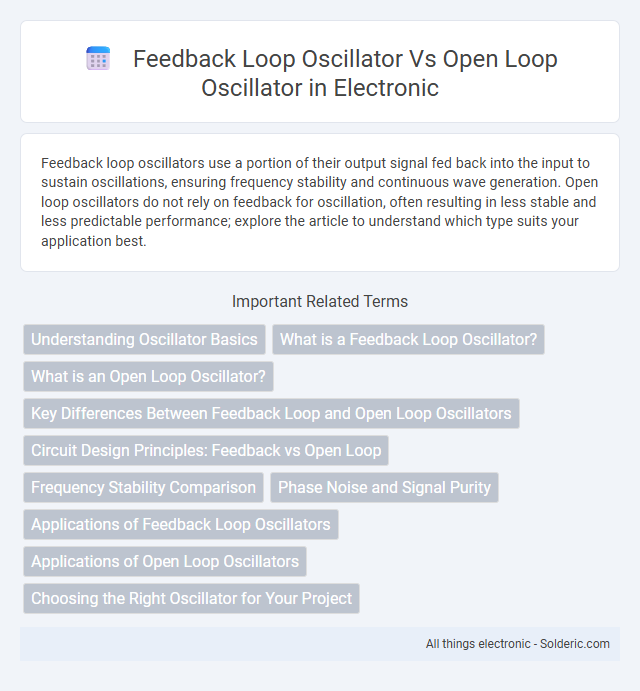Feedback loop oscillators use a portion of their output signal fed back into the input to sustain oscillations, ensuring frequency stability and continuous wave generation. Open loop oscillators do not rely on feedback for oscillation, often resulting in less stable and less predictable performance; explore the article to understand which type suits your application best.
Comparison Table
| Feature | Feedback Loop Oscillator | Open Loop Oscillator |
|---|---|---|
| Operation Principle | Uses output feedback to maintain oscillation | No feedback; relies on external input or initial conditions |
| Stability | Stable frequency due to feedback control | Less stable; frequency can drift without feedback |
| Frequency Control | Easily controlled via feedback network | Dependent on input or external forcing function |
| Output Waveform | Consistent, steady waveform | Variable waveform depending on input |
| Applications | Signal generation, timing circuits, RF oscillators | Open-loop sensors, startup transient analysis |
| Examples | LC oscillator, Crystal oscillator, RC phase shift oscillator | Ring oscillator without feedback, relaxation oscillator in startup phase |
Understanding Oscillator Basics
Feedback loop oscillators generate continuous waveforms by routing a portion of the output signal back into the input, creating a stable oscillation through positive feedback. Open loop oscillators lack this feedback mechanism and rely on external input signals to produce oscillations, often resulting in less stable or non-sustained outputs. Understanding oscillator basics involves recognizing that feedback loop oscillators, such as LC or crystal oscillators, provide consistent frequency generation critical in communication systems, while open loop oscillators serve functions where controlled or triggered oscillations are needed.
What is a Feedback Loop Oscillator?
A feedback loop oscillator is an electronic circuit that generates a continuous periodic signal by feeding a portion of its output back into its input, typically using amplifiers and frequency-selective components like inductors and capacitors. This self-sustaining feedback mechanism ensures that the oscillations maintain a steady frequency and amplitude, crucial in RF signal generation and clock circuits. Unlike open loop oscillators, which rely on external triggering, feedback loop oscillators operate autonomously through internal regenerative feedback.
What is an Open Loop Oscillator?
An Open Loop Oscillator operates without a feedback mechanism, generating oscillations based solely on an external input signal or inherent circuit properties like resonance. Unlike a Feedback Loop Oscillator, which relies on continuous signal feedback to sustain oscillations, the open loop design produces signals that may require precise tuning and external stabilization to maintain a consistent frequency. Your choice between these oscillators depends on the desired signal stability and the complexity of the circuit design.
Key Differences Between Feedback Loop and Open Loop Oscillators
Feedback loop oscillators rely on a feedback signal to sustain oscillations by continuously reinforcing the input, whereas open loop oscillators generate oscillations without any feedback, typically using active components like transistors or operational amplifiers. Key differences include stability and frequency accuracy; feedback loop oscillators offer better frequency stability due to the feedback mechanism, while open loop oscillators may exhibit less precision but simpler construction. Understanding these distinctions helps you choose the right oscillator type for applications requiring either stable frequency generation or simplicity in design.
Circuit Design Principles: Feedback vs Open Loop
Feedback loop oscillators rely on a closed-loop circuit where the output is fed back to the input to sustain oscillations, ensuring signal stability and consistent frequency generation. Open loop oscillators, in contrast, operate without feedback, depending solely on an external input or initial signal to generate oscillations, often resulting in less stable output frequencies. Your choice between these designs impacts frequency precision, with feedback loop oscillators typically offering enhanced control through regenerative signal reinforcement.
Frequency Stability Comparison
Feedback loop oscillators exhibit superior frequency stability due to their self-correcting mechanisms that continuously adjust the output frequency based on the feedback signal, minimizing drift caused by component variations and environmental changes. Open loop oscillators lack this corrective feedback, leading to greater susceptibility to frequency drift and less consistent output over time. Consequently, feedback loop oscillators are preferred in applications requiring precise and stable frequency control.
Phase Noise and Signal Purity
Feedback loop oscillators typically exhibit lower phase noise and higher signal purity due to the regeneration of the signal through positive feedback, which stabilizes the oscillation frequency and reduces unwanted spectral components. Open loop oscillators often suffer from higher phase noise since they lack the feedback mechanism that corrects frequency deviations, resulting in more phase jitter and spurious signals. Consequently, feedback loop oscillators are preferred in applications demanding precise frequency stability and clean spectral output.
Applications of Feedback Loop Oscillators
Feedback loop oscillators are widely used in communication systems for signal generation and frequency synthesis due to their ability to maintain a stable output frequency through continuous feedback. Common applications include radio transmitters, clock generators in digital circuits, and phase-locked loops (PLLs) for frequency stabilization and signal recovery. Your design benefits from their precise frequency control and low phase noise, which are critical in wireless communication and signal processing.
Applications of Open Loop Oscillators
Open loop oscillators are primarily used in applications requiring a stable frequency source without automatic frequency correction, such as in low-power RF communication devices and simple signal generators. These oscillators are ideal when you need predictable frequency output with minimal complexity and cost, which suits designs like crystal oscillators in digital circuits. Your choice for open loop oscillators should consider the trade-off between frequency stability and circuit simplicity for effective implementation in these specific use cases.
Choosing the Right Oscillator for Your Project
Choosing the right oscillator for your project depends on factors such as frequency stability, design complexity, and signal purity. Feedback loop oscillators offer high frequency stability and phase noise performance, making them ideal for precise applications like communication systems or signal generators. Open loop oscillators, while simpler and faster to design, may suffer from frequency drift and lower signal quality, better suited for applications where cost and simplicity take priority over precision.
Feedback loop oscillator vs Open loop oscillator Infographic

 solderic.com
solderic.com